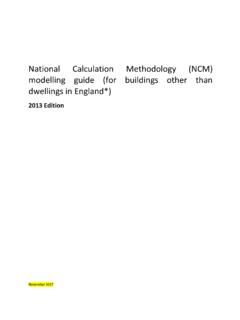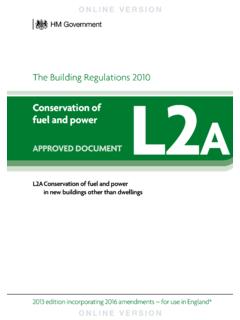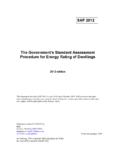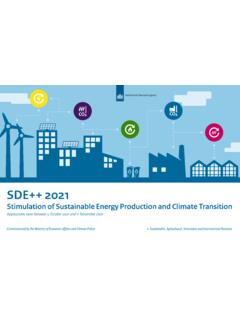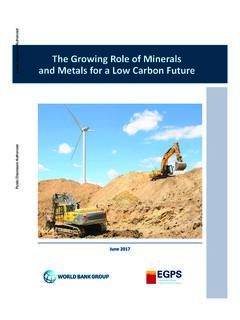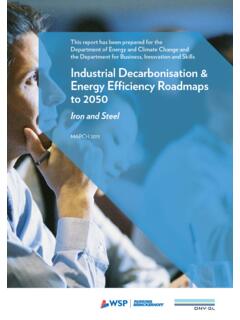Transcription of Product Carbon Footprinting – a study on methodologies …
1 European Commission DG Environment Product Carbon Footprinting a study on methodologies and initiatives Final report July 2010 This report merely acts as a guideline document for policy makers and does not seek to establish the Commission's future policy in this area. The contents and views contained in this report are those of the authors, and do not necessarily represent those of the European Commission. Neither the European Commission nor any person acting on behalf of the Commission is responsible for the use which might be made of the following information Contents A.
2 Introduction .. 3 B. Executive summary .. 7 C. Identification of main methodologies and 19 1. study of existing methodologies and initiatives .. 19 2. Selection of major methodologies and initiatives .. 27 D. Focus on the methodological options .. 34 1. calculation and technical features .. 34 2. Implementation system .. 72 E. Scenario building .. 73 1. General objectives of PCF policies .. 73 2. General description of the scenarios .. 74 3. Presentation of the limitations in the scenario building and analysis .. 77 4. Scenario 0: Business as usual.
3 82 5. Scenario 1: Favouring the internal use of PCF by companies .. 85 6. Scenario 2: Encouraging communication to 90 7. Scenario 3: Implementing market-based incentives .. 99 8. Scenario 4: Setting minimum requirements .. 105 9. Impact of technical elements on the scenarios .. 110 10. methodologies assessment .. 114 F. Conclusions .. 131 Appendix 1: Detailed analysis of major methodologies and initiatives .. 134 Appendix 2: Detailed grading 267 Appendix 3: Explanation of the weighting of the grading system .. 284 Appendix 4: Detailed assessment of methodologies .
4 287 Appendix 5: Complements on burden shifting .. 298 Appendix 6: Bibliography .. 303 study made by Ernst & Young France and Quantis for the European Commission DG Environment. Contacts Eric Mugnier (Ernst & Young) +33 1 46 93 78 15 Anthony Mairet (Ernst & Young) + 33 1 46 93 69 72 Julien Boucher (Quantis) +41 21 693 91 93 3 Ernst & Young and Quantis for European Commission (DG ENV) Product Carbon Footprinting a study on methodologies and initiatives A. Introduction A range of policies are in place to improve the energy and environmental performance of products.
5 The Ecodesign (EuP) Directive1 establishes a framework for setting ecodesign requirements for energy-using products. A number of other pieces of legislation address specific aspects of the life-cycle of products, such as waste. The labelling schemes set by the Energy Labelling Directive2, the Energy Star Regulation3, the Ecolabel Regulation4 and other schemes developed by Member States, retailers and other economic operators provide consumers with information on the energy and environmental performance of products. Incentives and public procurement are being implemented by Member States to stimulate the better performance of products.
6 The Energy Star Regulation also obliges EU institutions and Member State authorities to purchase office equipment meeting specific levels of energy efficiency. However, a number of shortcomings are hampering the potential of these policies. Most Product legislation addresses only specific aspects of a Product s life-cycle. While the Ecodesign Directive takes a life-cycle perspective, the environmental impact of energy-using products currently covered by the Directive only account for 31-36% of the environmental impact of products5. Information to consumers under EU policy has focused on energy efficiency for household appliances and office equipment under the Energy Labelling Directive and Energy Star Programme, or has covered only a limited number of products (under the Ecolabel).
7 Finally, actions at national level are not coordinated. In its conclusions on the Sustainable Production and Consumption Action Plan the Council of the European Union invited the European Commission to study the possibility of introducing the Carbon footprint of products in the existing EU environmental labelling instruments such as the Eco-label and energy labelling; and, taking into account Member States' experience, to start working as soon as possible on common voluntary methodologies facilitating the future establishment of Carbon assessments for organisations and the calculation of the Carbon footprint of products.
8 There are now many different methodologies under development for the ' Carbon Footprinting ' of products in a number of EU countries and in other countries around the world. Some of these initiatives aim to develop the measurement of Carbon Footprinting into labelling schemes, while others focus on the efficiency benefits companies can gain from undertaking Carbon analysis of their products. Given the different approaches used in these methodologies and initiatives, it is important for the Commission to prepare a sound analysis of these methodologies and initiatives, which would be an adequate input for considering options in the area of Carbon footprint of products.
9 1 Directive 2005/32/EC of the European Parliament and of the Council establishing a framework for the setting of ecodesign requirements for energy-using products. 2 Council Directive 92/75/EEC of 22 September 1992 on the indication by labelling and standard Product information of the consumption of energy and other resources by household appliances. 3 Regulation (EC) No 106/2008 of the European Parliament and of the Council of 15 January 2008 on a Community energy efficiency labelling programme for office equipment.
10 4 Regulation (EC) No 1980/2000 of the European Parliament and of the Council of 17 July 2000 on a revised Community ecolabel award scheme. 5 See Staff Working Paper SEC (2008) 2110 Impact assessment for recast of Directive 2005/32/EC, Table 3. 4 Ernst & Young and Quantis for European Commission (DG ENV) Product Carbon Footprinting a study on methodologies and initiatives The objective of this study is to identify, analyse and compare the existing major methodologies and initiatives in the field of Product Carbon Footprinting . The analysis aims to get a clear picture of the existing methodologies and initiatives in the EU and globally, and of features that might be relevant for future policy development.










